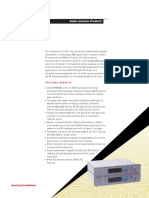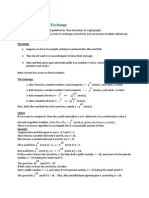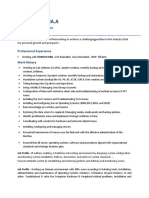Class+Notes5 Diffie+Hellman+Key+Exchange+Algorithm
Class+Notes5 Diffie+Hellman+Key+Exchange+Algorithm
Uploaded by
k5c6hdvmq7Copyright:
Available Formats
Class+Notes5 Diffie+Hellman+Key+Exchange+Algorithm
Class+Notes5 Diffie+Hellman+Key+Exchange+Algorithm
Uploaded by
k5c6hdvmq7Original Title
Copyright
Available Formats
Share this document
Did you find this document useful?
Is this content inappropriate?
Copyright:
Available Formats
Class+Notes5 Diffie+Hellman+Key+Exchange+Algorithm
Class+Notes5 Diffie+Hellman+Key+Exchange+Algorithm
Uploaded by
k5c6hdvmq7Copyright:
Available Formats
Diffie Hellman Key Exchange Algorithm
Whitefield Diffie and Martin Hellman develop Diffie Hellman key exchange Algorithms in
1976 to overcome the problem of key agreement and exchange. It enables the two parties
who want to communicate with each other to agree on a symmetric key, a key that can be
used for encrypting and decryption; note that Diffie Hellman key exchange algorithm can be
used for only key exchange, not for encryption and decryption process. The algorithm is
based on mathematical principles.
The Diffie-Hellman key exchange was one of the most important developments in public-key
cryptography (Symmetric key cryptography) and it is still frequently implemented in a range
of today’s different security protocols. It allows two parties who have not previously met to
securely establish a key which they can use to secure their communications. In this article,
we’ll explain what it’s used for, how it works on a step-by-step basis, its different variations,
as well as the security considerations that need to be noted in order to implement it safely.
1. The protocol enables 2 users to establish a secret key using a public key scheme based on
discrete algorithms.
2. The protocol is secure only if the authenticity of the 2 participants (Alice and Bob) can be
established.
3. or this scheme, there are 2 publicly known prime numbers :
o Consider a prime number q
o Another prime number p that is a primitive root of q, where p < q.
(Note: Primitive root of a prime number P is one, whose powers module P generate all the
images from 1 to P-1)
4. Suppose users Alice and Bob wish to exchange the key.
Alice selects a random integer x<q and computes
5. Alice sends the number A to Bob.
6. Bob independently selects another random integer y<q and compute
7. Bob sends the number B to Alice.
8. Alice now computes the secret key K1 as:
9. Bob alo computes the secret key K2 as:
K1 is actually equal to K2.
Example:
Step 1: Alice and Bob get prime numbers q = 11, p = 7 (p is a
primitive root of q)
Step 2: Alice selected a random number x = 3 and
Bob selected a random number y = 6
Step 3: Alice and Bob compute A and B
Alice: A =(7^3 mod 11) = (343 mod 11) = 2
Bob: B = (7^6 mod 11) = (117649 mod 11) = 4
Step 4: Alice and Bob exchange public numbers A and B
Step 5: Alice receives public key B = 4 and
Bob receives public key A = 2
Step 6: Alice and Bob compute symmetric keys K1 and K2
Alice: K1 = B^x mod q = 4^3 mod 11 = 64 mod 11 = 9
Bob: kb = A^y mod q = 2^6 mod 11 = 64 mod 11 = 9
Step 7: 9 is the shared secret.
You might also like
- GSM-R/ETCS Integration ReviewDocument82 pagesGSM-R/ETCS Integration ReviewTiémogo TRAORENo ratings yet
- CD Link: Digital Uncompressed Studio-Transmitter LinkDocument2 pagesCD Link: Digital Uncompressed Studio-Transmitter LinkJun LenteNo ratings yet
- TBS Answer Question No 1Document2 pagesTBS Answer Question No 1deepNo ratings yet
- Elliptic Curve CryptographyDocument30 pagesElliptic Curve CryptographyAsha MuruganNo ratings yet
- Group B-Assignment No. 1 : CNSL Te-ItDocument3 pagesGroup B-Assignment No. 1 : CNSL Te-ItPriyanshu AgrawalNo ratings yet
- Diffie HellmanDocument2 pagesDiffie Hellmanapi-3737802No ratings yet
- Cys535 Lecture06Document37 pagesCys535 Lecture06Waseem LaghariNo ratings yet
- Motivation For Key Exchange AlgorithmDocument3 pagesMotivation For Key Exchange AlgorithmDejene TechaneNo ratings yet
- Exp 05Document4 pagesExp 0548Nara Amit GopalNo ratings yet
- Diffie-Hellman Key Exchange: The SetupDocument2 pagesDiffie-Hellman Key Exchange: The SetupRam BabuNo ratings yet
- CHAPTER 05 - Public-Key CryptographyDocument29 pagesCHAPTER 05 - Public-Key CryptographyPNo ratings yet
- Assignment No 6Document3 pagesAssignment No 6spNo ratings yet
- CH 10Document24 pagesCH 10mofreh hogoNo ratings yet
- Public Key CryptographyDocument34 pagesPublic Key Cryptographyprayas satkarNo ratings yet
- Diffle HuffmanDocument29 pagesDiffle HuffmanAnkit RajNo ratings yet
- Cryptography and Network SecurityDocument25 pagesCryptography and Network SecurityViraj KumarNo ratings yet
- Diffie Hellman WriteupDocument3 pagesDiffie Hellman WriteupSumitThoratNo ratings yet
- Cys505 Lecture05 06Document37 pagesCys505 Lecture05 06Abdirizak AbokarNo ratings yet
- DiffieDocument24 pagesDiffieDuttaUdayaVenkataChegondiNo ratings yet
- Diffie HellmanDocument1 pageDiffie HellmanAhmed HeshamNo ratings yet
- Cryptography and Network Security: Fifth Edition by William StallingsDocument41 pagesCryptography and Network Security: Fifth Edition by William StallingsDineshkumar SNo ratings yet
- Diff RuthranDocument3 pagesDiff Ruthranruthranshiva9No ratings yet
- CHAPTER 5: Public-Key Cryptography I. RSA: Two Different KeysDocument43 pagesCHAPTER 5: Public-Key Cryptography I. RSA: Two Different KeysMin KhantNo ratings yet
- Aim: To Implement Diffiehellman Key Exchange Protocol. Theory: Diffiehellman Key Exchange Is A Cryptographic Protocol That Allows TwoDocument3 pagesAim: To Implement Diffiehellman Key Exchange Protocol. Theory: Diffiehellman Key Exchange Is A Cryptographic Protocol That Allows Twocreative_g33kNo ratings yet
- Public Cryptosystem RDocument12 pagesPublic Cryptosystem RgamerNo ratings yet
- Diffie Hellman Key ExchangeDocument8 pagesDiffie Hellman Key ExchangeAnonymous SNij6R3PNo ratings yet
- 26-Practice Problems-14-03-2024Document12 pages26-Practice Problems-14-03-2024Aditya ChedeNo ratings yet
- Diffie Hellman Key Exchange Algorithm For Key GenerationDocument5 pagesDiffie Hellman Key Exchange Algorithm For Key Generationshahrbano 14No ratings yet
- Diffie Hellman Key Exchange AlgorithmDocument14 pagesDiffie Hellman Key Exchange Algorithmmoti sutharNo ratings yet
- ISS Module 5,6 Searchable - MergedDocument45 pagesISS Module 5,6 Searchable - MergedjangalasidduNo ratings yet
- Transposition and DiffiDocument14 pagesTransposition and DiffiShubham MittalNo ratings yet
- CSE 5636 - Network Security CYB 5290 - Secure Data Communica Ons and Networks Public Key Cryptography IDocument21 pagesCSE 5636 - Network Security CYB 5290 - Secure Data Communica Ons and Networks Public Key Cryptography IVikram GuptaNo ratings yet
- Unit 2Document11 pagesUnit 2alagar samyNo ratings yet
- Module 4Document30 pagesModule 4Prakash SaubhariNo ratings yet
- Transposition Techniques (Class-L7)Document49 pagesTransposition Techniques (Class-L7)Mahender Taneja0% (1)
- 19-Diffie-Hellman Key Exchange Algorithm-24-02-2024Document11 pages19-Diffie-Hellman Key Exchange Algorithm-24-02-2024thefifthmarauderNo ratings yet
- Question Bank CssDocument34 pagesQuestion Bank Csslojojan871No ratings yet
- Mật mã ứng dụngDocument4 pagesMật mã ứng dụngKiên TrungNo ratings yet
- Cryptography CS 555: Topic 16: Key Management and The Need For Public Key CryptographyDocument21 pagesCryptography CS 555: Topic 16: Key Management and The Need For Public Key Cryptographycrazz1No ratings yet
- Bitcoin Encryption Decryption DSADocument16 pagesBitcoin Encryption Decryption DSASrinivas Mahankali100% (1)
- Diffie-Hellman Key ExchangeDocument20 pagesDiffie-Hellman Key ExchangecezilcNo ratings yet
- Ex 6,7Document8 pagesEx 6,72K20 B3 11 Arun KumarNo ratings yet
- EccDocument19 pagesEccRathin RajNo ratings yet
- ReportDocument2 pagesReportLama HasanNo ratings yet
- WINSEM2017-18 - CSE4003 - ETH - SJT505 - VL2017185003783 - Reference Material I - 005IDEADocument3 pagesWINSEM2017-18 - CSE4003 - ETH - SJT505 - VL2017185003783 - Reference Material I - 005IDEAgovindNo ratings yet
- Implementation of Diffie-Hellman Algorithm - GeeksforGeeksDocument6 pagesImplementation of Diffie-Hellman Algorithm - GeeksforGeeksGodwin K NyamukondiwaNo ratings yet
- Diffie Hellman PDFDocument6 pagesDiffie Hellman PDFsushmaNo ratings yet
- Diffie-Hellman Key ExchangeDocument7 pagesDiffie-Hellman Key ExchangedeekshantNo ratings yet
- 作业要求Document19 pages作业要求w18638052767No ratings yet
- Public Key Cryptography and Cryptographic Hashes: CS461/ECE422 Fall 2010Document46 pagesPublic Key Cryptography and Cryptographic Hashes: CS461/ECE422 Fall 2010Cris OlipasNo ratings yet
- Chapter 3 Data Security (DR - Atef)Document44 pagesChapter 3 Data Security (DR - Atef)JonathanHindiNo ratings yet
- Publickey CrptographyDocument12 pagesPublickey CrptographyDhanapal AngNo ratings yet
- 4.2. Cryptographic Coding (Part 2)Document27 pages4.2. Cryptographic Coding (Part 2)ReachNo ratings yet
- Diffie-Hellman Key ExchangeDocument6 pagesDiffie-Hellman Key ExchangeMilica LukicNo ratings yet
- 14 Pubkeycrypto NotesDocument9 pages14 Pubkeycrypto NoteshuongdtthNo ratings yet
- Public KeyDocument39 pagesPublic KeyMunish kumarNo ratings yet
- NS2 CryptoProtocolsIIDocument46 pagesNS2 CryptoProtocolsIIThai TranNo ratings yet
- Simplified IDEA AlgorithmDocument16 pagesSimplified IDEA AlgorithmKéké DocteurNo ratings yet
- Wireless Comm Systems 4Document37 pagesWireless Comm Systems 4abdulsahibNo ratings yet
- Cryptography 3Document25 pagesCryptography 3Venera MakhambayevaNo ratings yet
- Infineon Wireless Communication AG 2023 ProductBrochure v01 01 enDocument36 pagesInfineon Wireless Communication AG 2023 ProductBrochure v01 01 enrajkumar.araciontechNo ratings yet
- 3DES - CBC - Sweet32 - Birthday Attacks On 64-Bit Block Ciphers in TLS and OpenVPN PDFDocument9 pages3DES - CBC - Sweet32 - Birthday Attacks On 64-Bit Block Ciphers in TLS and OpenVPN PDFsipteckNo ratings yet
- Ec7105-Microwave EngineeringDocument9 pagesEc7105-Microwave EngineeringKushal GellaNo ratings yet
- Competitive AdvantegesDocument8 pagesCompetitive AdvantegesMarcos RonderosNo ratings yet
- Operating Instructions For Your Cobra 29 LTD BTDocument21 pagesOperating Instructions For Your Cobra 29 LTD BTManga ShurikenNo ratings yet
- General Architecture OF OCB-283Document34 pagesGeneral Architecture OF OCB-283vdurairaju87No ratings yet
- A 9GSps 1.125-GHz BW Oversampling Continuous-Time Pipeline ADC Achieving - 164dBFSpHz NSDDocument16 pagesA 9GSps 1.125-GHz BW Oversampling Continuous-Time Pipeline ADC Achieving - 164dBFSpHz NSDHoang NguyenNo ratings yet
- T Rec Q.81.3 199109 I!!pdf eDocument45 pagesT Rec Q.81.3 199109 I!!pdf esurya5458No ratings yet
- Web Application Firewall (WAF) : Alexander Endraca, Bryan King, George Nodalo, Maricone Sta. Maria, and Isaac SabasDocument5 pagesWeb Application Firewall (WAF) : Alexander Endraca, Bryan King, George Nodalo, Maricone Sta. Maria, and Isaac Sabaspenumudi233No ratings yet
- Vamsi Krishna.A: Professional ExperienceDocument3 pagesVamsi Krishna.A: Professional Experiencemkm969No ratings yet
- Implementing VRRP CiscoDocument34 pagesImplementing VRRP CiscoJames OmaraNo ratings yet
- Subnetwork Id: Integer: 0 To 4095Document44 pagesSubnetwork Id: Integer: 0 To 4095Debi Prasad DashNo ratings yet
- Sicam Sat 1703 Acp Rtu PDFDocument12 pagesSicam Sat 1703 Acp Rtu PDFRICARDONo ratings yet
- What Is A Computer NetworkDocument3 pagesWhat Is A Computer Networkhautv.22itbNo ratings yet
- Wireless Motorola MC 9500 Manual PDFDocument112 pagesWireless Motorola MC 9500 Manual PDFnelson_santosNo ratings yet
- Flyaway AntennaDocument2 pagesFlyaway AntennaKalu NkwNo ratings yet
- Lecture 0Document32 pagesLecture 0vikrant kumarNo ratings yet
- FM 1100Document45 pagesFM 1100ArtisticSolution MediaHouseNo ratings yet
- Statys XS - Catalogue Pages - 2018 07 - Dcg142033ap - en Apac 1Document2 pagesStatys XS - Catalogue Pages - 2018 07 - Dcg142033ap - en Apac 1Alfn OjanNo ratings yet
- Passage Plan Check List: Departure ArrivalDocument6 pagesPassage Plan Check List: Departure ArrivalMario disi100% (1)
- RRU5909s Hardware DescriptionDocument30 pagesRRU5909s Hardware DescriptionDmitry059No ratings yet
- Atsam4l PDFDocument1,207 pagesAtsam4l PDFBárbara CastilhoNo ratings yet
- FM Generation by V CoDocument2 pagesFM Generation by V Cofatkul_mujibNo ratings yet
- Zigbee Thesis ProjectDocument6 pagesZigbee Thesis Projectgcq5c1pv100% (2)
- 4-Channel Mobile DVRDocument2 pages4-Channel Mobile DVRErwin HernandezNo ratings yet
- Hsdpa: 3G Communications Protocol High-Speed Packet AccessDocument2 pagesHsdpa: 3G Communications Protocol High-Speed Packet AccessBiswajit MohantyNo ratings yet
- Lab - Securing The Router For Administrative Access: Taller 2Document28 pagesLab - Securing The Router For Administrative Access: Taller 2murcielago189No ratings yet
- Vpls Auto BGP RRDocument16 pagesVpls Auto BGP RRhector_ninoskaNo ratings yet

























































































